E-Learning: Strategies for Marketing, Revenue, and Social Media Impact
VerifiedAdded on 2021/05/31
|13
|3283
|22
Report
AI Summary
This report delves into the evolving landscape of e-learning, particularly within higher education, analyzing how universities are leveraging online platforms for growth and revenue generation. It examines various marketing strategies, such as rewarding students for referrals and utilizing social media platforms like Facebook and LinkedIn to reach a wider audience. The report also explores innovative revenue models, including the sale of e-books and pre-configured laptops bundled with course materials. Furthermore, it investigates the impact of social media on e-learning, highlighting both the benefits and challenges of online interactions, and the need for employee training in managing online presence. The study also references the Cisco Online Learning Solution Architecture and the Business Process Management (BPM) approach to improve the e-learning process. The paper also includes details on how universities in Poland are implementing e-learning programs.
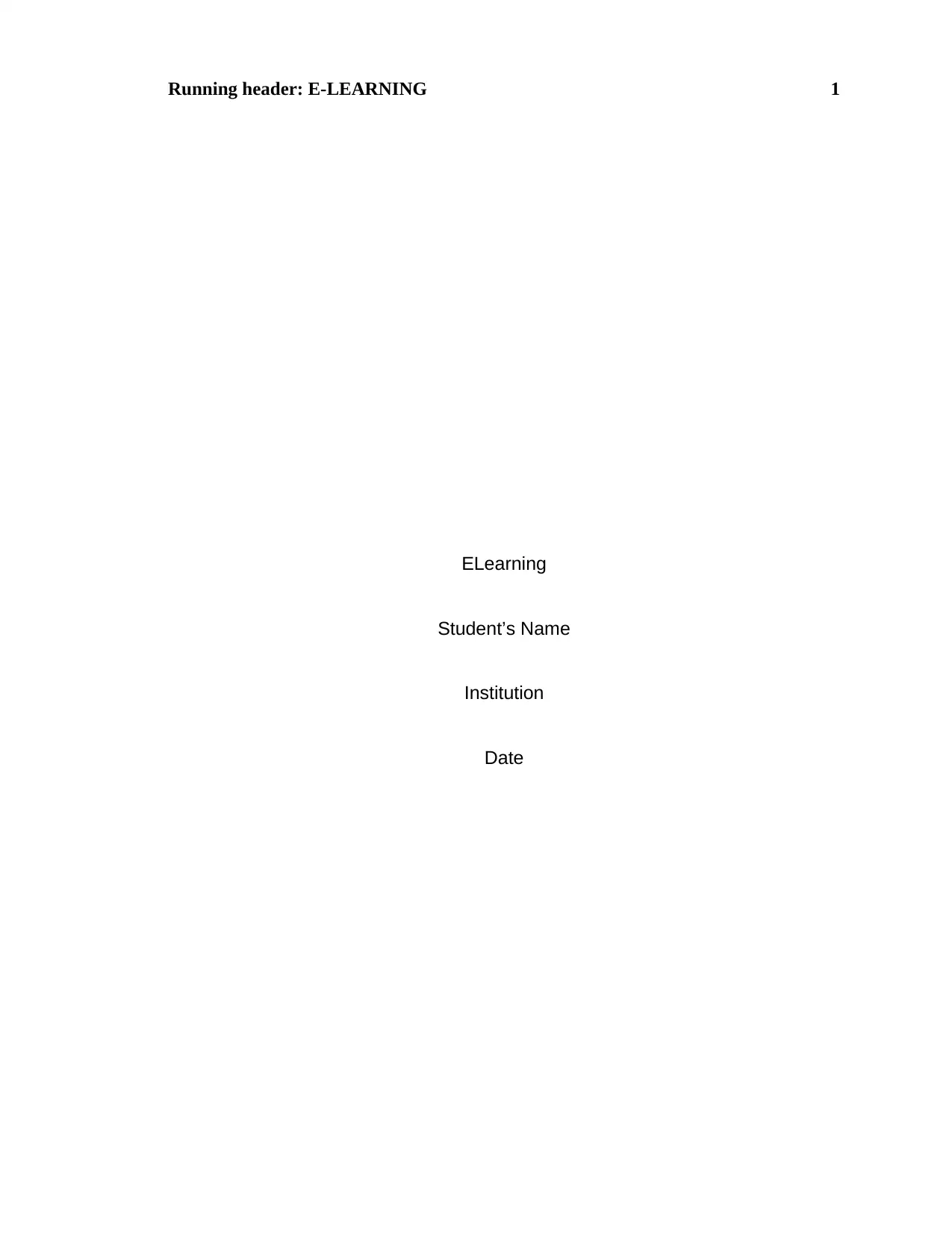
Running header: E-LEARNING 1
ELearning
Student’s Name
Institution
Date
ELearning
Student’s Name
Institution
Date
Paraphrase This Document
Need a fresh take? Get an instant paraphrase of this document with our AI Paraphraser
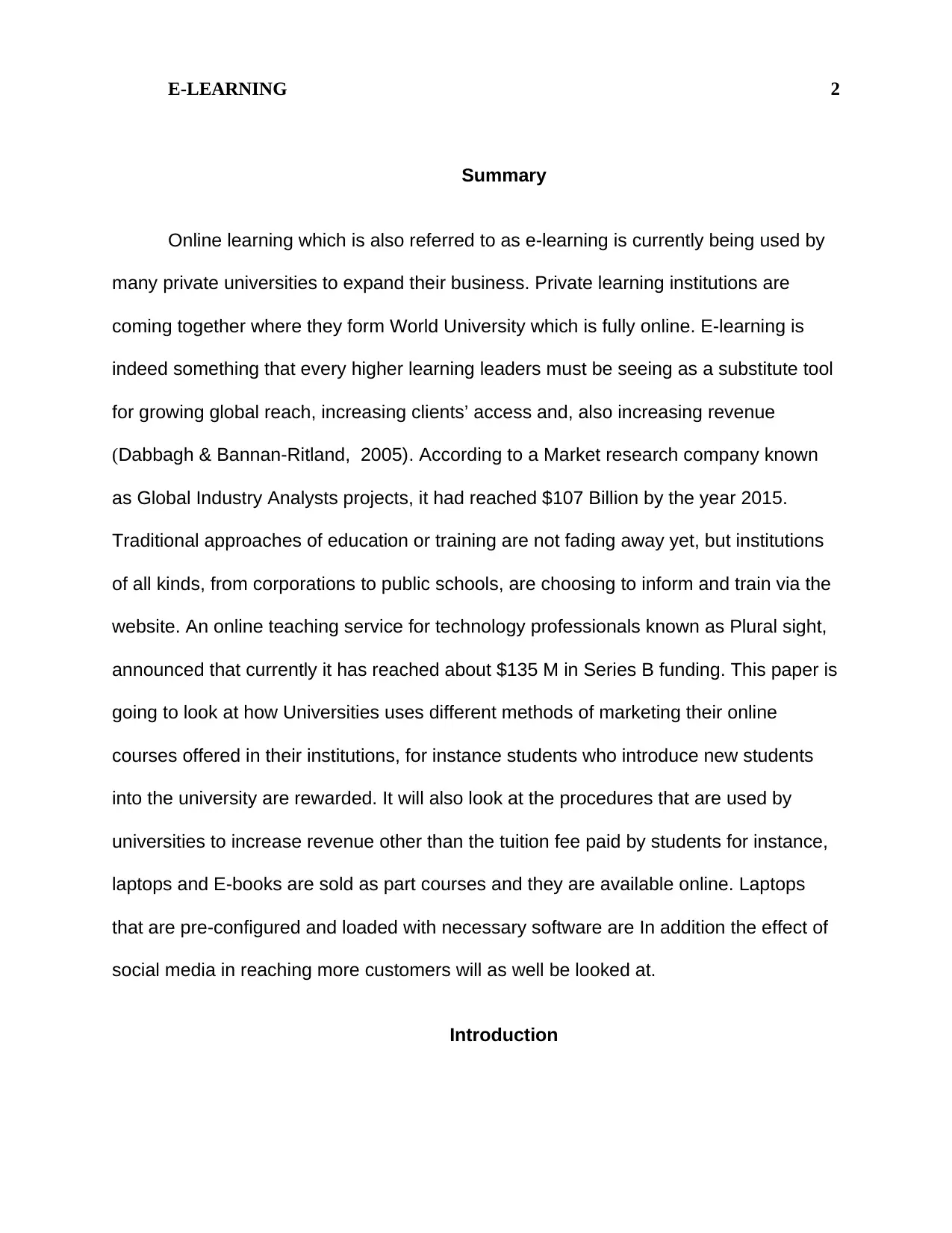
E-LEARNING 2
Summary
Online learning which is also referred to as e-learning is currently being used by
many private universities to expand their business. Private learning institutions are
coming together where they form World University which is fully online. E-learning is
indeed something that every higher learning leaders must be seeing as a substitute tool
for growing global reach, increasing clients’ access and, also increasing revenue
(Dabbagh & Bannan-Ritland, 2005). According to a Market research company known
as Global Industry Analysts projects, it had reached $107 Billion by the year 2015.
Traditional approaches of education or training are not fading away yet, but institutions
of all kinds, from corporations to public schools, are choosing to inform and train via the
website. An online teaching service for technology professionals known as Plural sight,
announced that currently it has reached about $135 M in Series B funding. This paper is
going to look at how Universities uses different methods of marketing their online
courses offered in their institutions, for instance students who introduce new students
into the university are rewarded. It will also look at the procedures that are used by
universities to increase revenue other than the tuition fee paid by students for instance,
laptops and E-books are sold as part courses and they are available online. Laptops
that are pre-configured and loaded with necessary software are In addition the effect of
social media in reaching more customers will as well be looked at.
Introduction
Summary
Online learning which is also referred to as e-learning is currently being used by
many private universities to expand their business. Private learning institutions are
coming together where they form World University which is fully online. E-learning is
indeed something that every higher learning leaders must be seeing as a substitute tool
for growing global reach, increasing clients’ access and, also increasing revenue
(Dabbagh & Bannan-Ritland, 2005). According to a Market research company known
as Global Industry Analysts projects, it had reached $107 Billion by the year 2015.
Traditional approaches of education or training are not fading away yet, but institutions
of all kinds, from corporations to public schools, are choosing to inform and train via the
website. An online teaching service for technology professionals known as Plural sight,
announced that currently it has reached about $135 M in Series B funding. This paper is
going to look at how Universities uses different methods of marketing their online
courses offered in their institutions, for instance students who introduce new students
into the university are rewarded. It will also look at the procedures that are used by
universities to increase revenue other than the tuition fee paid by students for instance,
laptops and E-books are sold as part courses and they are available online. Laptops
that are pre-configured and loaded with necessary software are In addition the effect of
social media in reaching more customers will as well be looked at.
Introduction
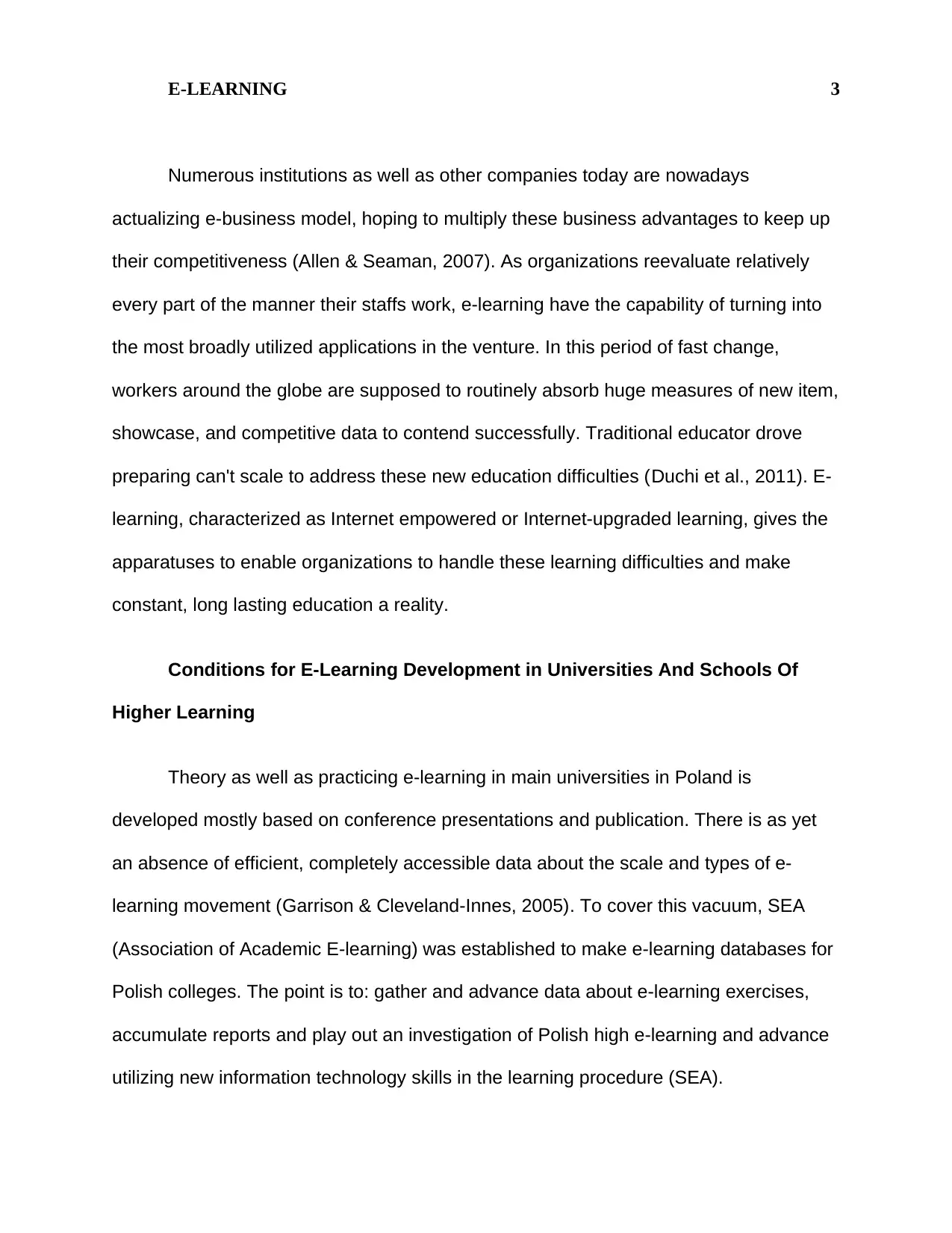
E-LEARNING 3
Numerous institutions as well as other companies today are nowadays
actualizing e-business model, hoping to multiply these business advantages to keep up
their competitiveness (Allen & Seaman, 2007). As organizations reevaluate relatively
every part of the manner their staffs work, e-learning have the capability of turning into
the most broadly utilized applications in the venture. In this period of fast change,
workers around the globe are supposed to routinely absorb huge measures of new item,
showcase, and competitive data to contend successfully. Traditional educator drove
preparing can't scale to address these new education difficulties (Duchi et al., 2011). E-
learning, characterized as Internet empowered or Internet-upgraded learning, gives the
apparatuses to enable organizations to handle these learning difficulties and make
constant, long lasting education a reality.
Conditions for E-Learning Development in Universities And Schools Of
Higher Learning
Theory as well as practicing e-learning in main universities in Poland is
developed mostly based on conference presentations and publication. There is as yet
an absence of efficient, completely accessible data about the scale and types of e-
learning movement (Garrison & Cleveland-Innes, 2005). To cover this vacuum, SEA
(Association of Academic E-learning) was established to make e-learning databases for
Polish colleges. The point is to: gather and advance data about e-learning exercises,
accumulate reports and play out an investigation of Polish high e-learning and advance
utilizing new information technology skills in the learning procedure (SEA).
Numerous institutions as well as other companies today are nowadays
actualizing e-business model, hoping to multiply these business advantages to keep up
their competitiveness (Allen & Seaman, 2007). As organizations reevaluate relatively
every part of the manner their staffs work, e-learning have the capability of turning into
the most broadly utilized applications in the venture. In this period of fast change,
workers around the globe are supposed to routinely absorb huge measures of new item,
showcase, and competitive data to contend successfully. Traditional educator drove
preparing can't scale to address these new education difficulties (Duchi et al., 2011). E-
learning, characterized as Internet empowered or Internet-upgraded learning, gives the
apparatuses to enable organizations to handle these learning difficulties and make
constant, long lasting education a reality.
Conditions for E-Learning Development in Universities And Schools Of
Higher Learning
Theory as well as practicing e-learning in main universities in Poland is
developed mostly based on conference presentations and publication. There is as yet
an absence of efficient, completely accessible data about the scale and types of e-
learning movement (Garrison & Cleveland-Innes, 2005). To cover this vacuum, SEA
(Association of Academic E-learning) was established to make e-learning databases for
Polish colleges. The point is to: gather and advance data about e-learning exercises,
accumulate reports and play out an investigation of Polish high e-learning and advance
utilizing new information technology skills in the learning procedure (SEA).
⊘ This is a preview!⊘
Do you want full access?
Subscribe today to unlock all pages.

Trusted by 1+ million students worldwide
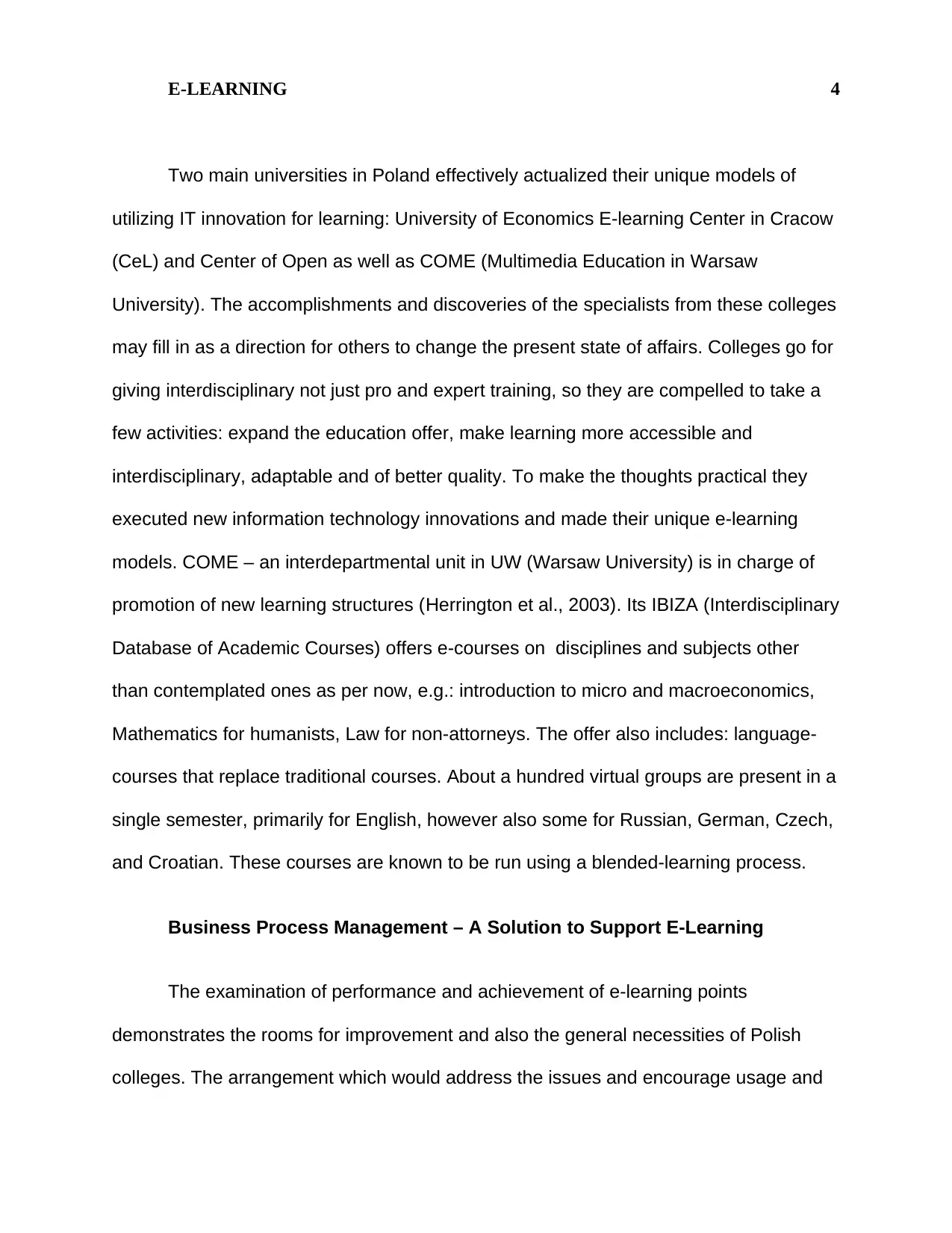
E-LEARNING 4
Two main universities in Poland effectively actualized their unique models of
utilizing IT innovation for learning: University of Economics E-learning Center in Cracow
(CeL) and Center of Open as well as COME (Multimedia Education in Warsaw
University). The accomplishments and discoveries of the specialists from these colleges
may fill in as a direction for others to change the present state of affairs. Colleges go for
giving interdisciplinary not just pro and expert training, so they are compelled to take a
few activities: expand the education offer, make learning more accessible and
interdisciplinary, adaptable and of better quality. To make the thoughts practical they
executed new information technology innovations and made their unique e-learning
models. COME – an interdepartmental unit in UW (Warsaw University) is in charge of
promotion of new learning structures (Herrington et al., 2003). Its IBIZA (Interdisciplinary
Database of Academic Courses) offers e-courses on disciplines and subjects other
than contemplated ones as per now, e.g.: introduction to micro and macroeconomics,
Mathematics for humanists, Law for non-attorneys. The offer also includes: language-
courses that replace traditional courses. About a hundred virtual groups are present in a
single semester, primarily for English, however also some for Russian, German, Czech,
and Croatian. These courses are known to be run using a blended-learning process.
Business Process Management – A Solution to Support E-Learning
The examination of performance and achievement of e-learning points
demonstrates the rooms for improvement and also the general necessities of Polish
colleges. The arrangement which would address the issues and encourage usage and
Two main universities in Poland effectively actualized their unique models of
utilizing IT innovation for learning: University of Economics E-learning Center in Cracow
(CeL) and Center of Open as well as COME (Multimedia Education in Warsaw
University). The accomplishments and discoveries of the specialists from these colleges
may fill in as a direction for others to change the present state of affairs. Colleges go for
giving interdisciplinary not just pro and expert training, so they are compelled to take a
few activities: expand the education offer, make learning more accessible and
interdisciplinary, adaptable and of better quality. To make the thoughts practical they
executed new information technology innovations and made their unique e-learning
models. COME – an interdepartmental unit in UW (Warsaw University) is in charge of
promotion of new learning structures (Herrington et al., 2003). Its IBIZA (Interdisciplinary
Database of Academic Courses) offers e-courses on disciplines and subjects other
than contemplated ones as per now, e.g.: introduction to micro and macroeconomics,
Mathematics for humanists, Law for non-attorneys. The offer also includes: language-
courses that replace traditional courses. About a hundred virtual groups are present in a
single semester, primarily for English, however also some for Russian, German, Czech,
and Croatian. These courses are known to be run using a blended-learning process.
Business Process Management – A Solution to Support E-Learning
The examination of performance and achievement of e-learning points
demonstrates the rooms for improvement and also the general necessities of Polish
colleges. The arrangement which would address the issues and encourage usage and
Paraphrase This Document
Need a fresh take? Get an instant paraphrase of this document with our AI Paraphraser
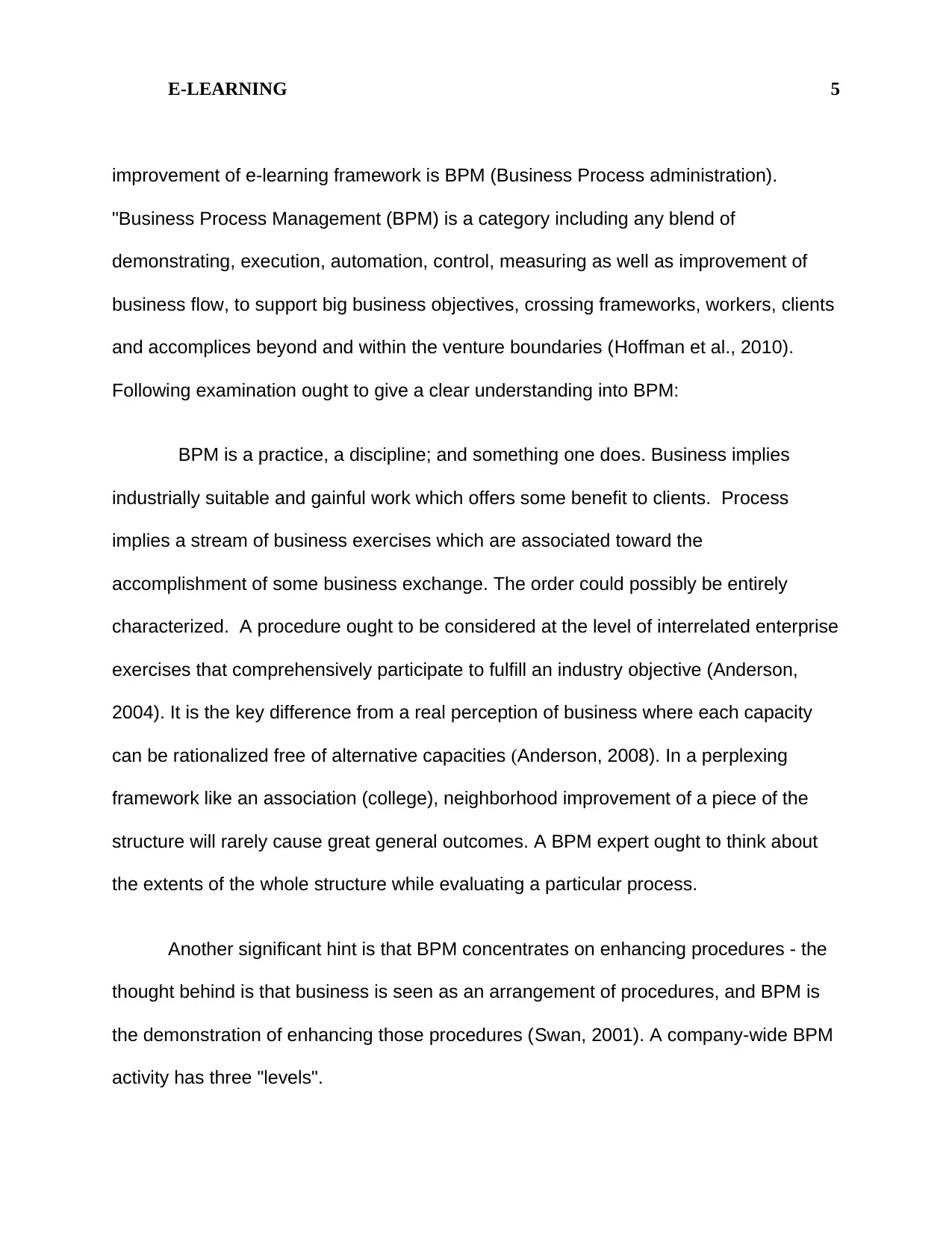
E-LEARNING 5
improvement of e-learning framework is BPM (Business Process administration).
"Business Process Management (BPM) is a category including any blend of
demonstrating, execution, automation, control, measuring as well as improvement of
business flow, to support big business objectives, crossing frameworks, workers, clients
and accomplices beyond and within the venture boundaries (Hoffman et al., 2010).
Following examination ought to give a clear understanding into BPM:
BPM is a practice, a discipline; and something one does. Business implies
industrially suitable and gainful work which offers some benefit to clients. Process
implies a stream of business exercises which are associated toward the
accomplishment of some business exchange. The order could possibly be entirely
characterized. A procedure ought to be considered at the level of interrelated enterprise
exercises that comprehensively participate to fulfill an industry objective (Anderson,
2004). It is the key difference from a real perception of business where each capacity
can be rationalized free of alternative capacities (Anderson, 2008). In a perplexing
framework like an association (college), neighborhood improvement of a piece of the
structure will rarely cause great general outcomes. A BPM expert ought to think about
the extents of the whole structure while evaluating a particular process.
Another significant hint is that BPM concentrates on enhancing procedures - the
thought behind is that business is seen as an arrangement of procedures, and BPM is
the demonstration of enhancing those procedures (Swan, 2001). A company-wide BPM
activity has three "levels".
improvement of e-learning framework is BPM (Business Process administration).
"Business Process Management (BPM) is a category including any blend of
demonstrating, execution, automation, control, measuring as well as improvement of
business flow, to support big business objectives, crossing frameworks, workers, clients
and accomplices beyond and within the venture boundaries (Hoffman et al., 2010).
Following examination ought to give a clear understanding into BPM:
BPM is a practice, a discipline; and something one does. Business implies
industrially suitable and gainful work which offers some benefit to clients. Process
implies a stream of business exercises which are associated toward the
accomplishment of some business exchange. The order could possibly be entirely
characterized. A procedure ought to be considered at the level of interrelated enterprise
exercises that comprehensively participate to fulfill an industry objective (Anderson,
2004). It is the key difference from a real perception of business where each capacity
can be rationalized free of alternative capacities (Anderson, 2008). In a perplexing
framework like an association (college), neighborhood improvement of a piece of the
structure will rarely cause great general outcomes. A BPM expert ought to think about
the extents of the whole structure while evaluating a particular process.
Another significant hint is that BPM concentrates on enhancing procedures - the
thought behind is that business is seen as an arrangement of procedures, and BPM is
the demonstration of enhancing those procedures (Swan, 2001). A company-wide BPM
activity has three "levels".
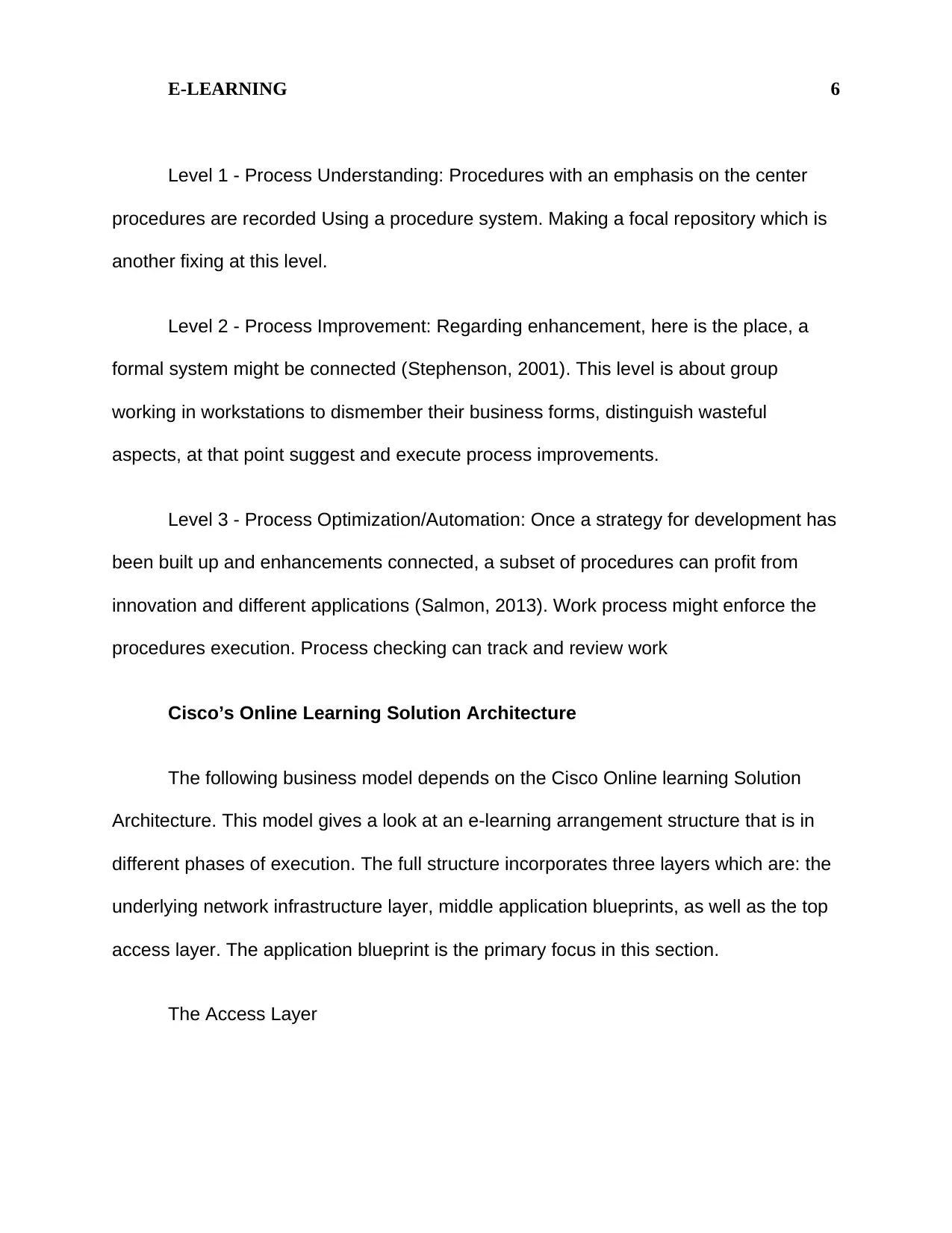
E-LEARNING 6
Level 1 - Process Understanding: Procedures with an emphasis on the center
procedures are recorded Using a procedure system. Making a focal repository which is
another fixing at this level.
Level 2 - Process Improvement: Regarding enhancement, here is the place, a
formal system might be connected (Stephenson, 2001). This level is about group
working in workstations to dismember their business forms, distinguish wasteful
aspects, at that point suggest and execute process improvements.
Level 3 - Process Optimization/Automation: Once a strategy for development has
been built up and enhancements connected, a subset of procedures can profit from
innovation and different applications (Salmon, 2013). Work process might enforce the
procedures execution. Process checking can track and review work
Cisco’s Online Learning Solution Architecture
The following business model depends on the Cisco Online learning Solution
Architecture. This model gives a look at an e-learning arrangement structure that is in
different phases of execution. The full structure incorporates three layers which are: the
underlying network infrastructure layer, middle application blueprints, as well as the top
access layer. The application blueprint is the primary focus in this section.
The Access Layer
Level 1 - Process Understanding: Procedures with an emphasis on the center
procedures are recorded Using a procedure system. Making a focal repository which is
another fixing at this level.
Level 2 - Process Improvement: Regarding enhancement, here is the place, a
formal system might be connected (Stephenson, 2001). This level is about group
working in workstations to dismember their business forms, distinguish wasteful
aspects, at that point suggest and execute process improvements.
Level 3 - Process Optimization/Automation: Once a strategy for development has
been built up and enhancements connected, a subset of procedures can profit from
innovation and different applications (Salmon, 2013). Work process might enforce the
procedures execution. Process checking can track and review work
Cisco’s Online Learning Solution Architecture
The following business model depends on the Cisco Online learning Solution
Architecture. This model gives a look at an e-learning arrangement structure that is in
different phases of execution. The full structure incorporates three layers which are: the
underlying network infrastructure layer, middle application blueprints, as well as the top
access layer. The application blueprint is the primary focus in this section.
The Access Layer
⊘ This is a preview!⊘
Do you want full access?
Subscribe today to unlock all pages.

Trusted by 1+ million students worldwide

E-LEARNING 7
The top access layer assists various audiences which includes all Cisco workers,
the business association, clients, and outside accomplices (Rovai & Jordan, 2004).
Every one of the addressees might have their access plans or entryway outlines tuned
towards their needs, for example, combined substance sources in view of normal
interests. Everybody access the e-learning from this entrance layer.
The Underlying Network Infrastructure
Accessing all Cisco’s leading-edge technologies and equipment, the e-learning
solution structure depends intensely on a strong system framework to organize a
significant number of the administrations that depend on the application layer (Allen &
Seaman, 2010). The design is based on CIN (Cisco Intelligent Network), which
guarantees performance, scalability, and accessibility, and in addition the capacity to at
the same time convey information, video and voice. It likewise oversees security, nature
of administration and distribution of a content.
The Applications Blueprint
The applications blueprint is partitioned into four practical territories— Delivery
Management Services, Learning Management Service, Business Operations Services,
and Content Management Services, that separate the procedures of origination,
advancement, conveyance, and administration into proper regions of duty and advance
cross-useful joining. This model is like those utilized for pas business wide application
executions at Cisco (Ally, 2004). The fitting and-play, secluded approach that gives the
The top access layer assists various audiences which includes all Cisco workers,
the business association, clients, and outside accomplices (Rovai & Jordan, 2004).
Every one of the addressees might have their access plans or entryway outlines tuned
towards their needs, for example, combined substance sources in view of normal
interests. Everybody access the e-learning from this entrance layer.
The Underlying Network Infrastructure
Accessing all Cisco’s leading-edge technologies and equipment, the e-learning
solution structure depends intensely on a strong system framework to organize a
significant number of the administrations that depend on the application layer (Allen &
Seaman, 2010). The design is based on CIN (Cisco Intelligent Network), which
guarantees performance, scalability, and accessibility, and in addition the capacity to at
the same time convey information, video and voice. It likewise oversees security, nature
of administration and distribution of a content.
The Applications Blueprint
The applications blueprint is partitioned into four practical territories— Delivery
Management Services, Learning Management Service, Business Operations Services,
and Content Management Services, that separate the procedures of origination,
advancement, conveyance, and administration into proper regions of duty and advance
cross-useful joining. This model is like those utilized for pas business wide application
executions at Cisco (Ally, 2004). The fitting and-play, secluded approach that gives the
Paraphrase This Document
Need a fresh take? Get an instant paraphrase of this document with our AI Paraphraser
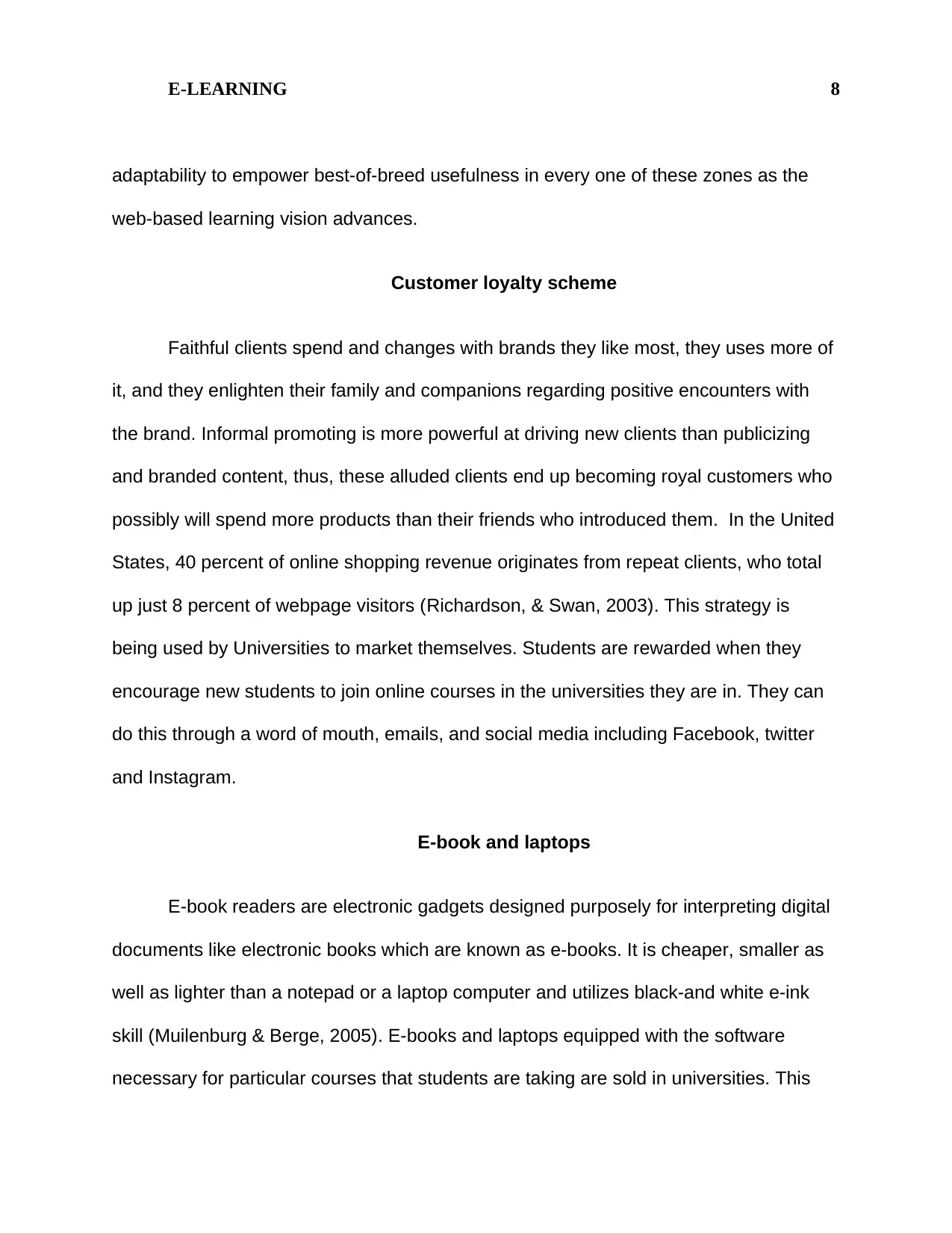
E-LEARNING 8
adaptability to empower best-of-breed usefulness in every one of these zones as the
web-based learning vision advances.
Customer loyalty scheme
Faithful clients spend and changes with brands they like most, they uses more of
it, and they enlighten their family and companions regarding positive encounters with
the brand. Informal promoting is more powerful at driving new clients than publicizing
and branded content, thus, these alluded clients end up becoming royal customers who
possibly will spend more products than their friends who introduced them. In the United
States, 40 percent of online shopping revenue originates from repeat clients, who total
up just 8 percent of webpage visitors (Richardson, & Swan, 2003). This strategy is
being used by Universities to market themselves. Students are rewarded when they
encourage new students to join online courses in the universities they are in. They can
do this through a word of mouth, emails, and social media including Facebook, twitter
and Instagram.
E-book and laptops
E-book readers are electronic gadgets designed purposely for interpreting digital
documents like electronic books which are known as e-books. It is cheaper, smaller as
well as lighter than a notepad or a laptop computer and utilizes black-and white e-ink
skill (Muilenburg & Berge, 2005). E-books and laptops equipped with the software
necessary for particular courses that students are taking are sold in universities. This
adaptability to empower best-of-breed usefulness in every one of these zones as the
web-based learning vision advances.
Customer loyalty scheme
Faithful clients spend and changes with brands they like most, they uses more of
it, and they enlighten their family and companions regarding positive encounters with
the brand. Informal promoting is more powerful at driving new clients than publicizing
and branded content, thus, these alluded clients end up becoming royal customers who
possibly will spend more products than their friends who introduced them. In the United
States, 40 percent of online shopping revenue originates from repeat clients, who total
up just 8 percent of webpage visitors (Richardson, & Swan, 2003). This strategy is
being used by Universities to market themselves. Students are rewarded when they
encourage new students to join online courses in the universities they are in. They can
do this through a word of mouth, emails, and social media including Facebook, twitter
and Instagram.
E-book and laptops
E-book readers are electronic gadgets designed purposely for interpreting digital
documents like electronic books which are known as e-books. It is cheaper, smaller as
well as lighter than a notepad or a laptop computer and utilizes black-and white e-ink
skill (Muilenburg & Berge, 2005). E-books and laptops equipped with the software
necessary for particular courses that students are taking are sold in universities. This
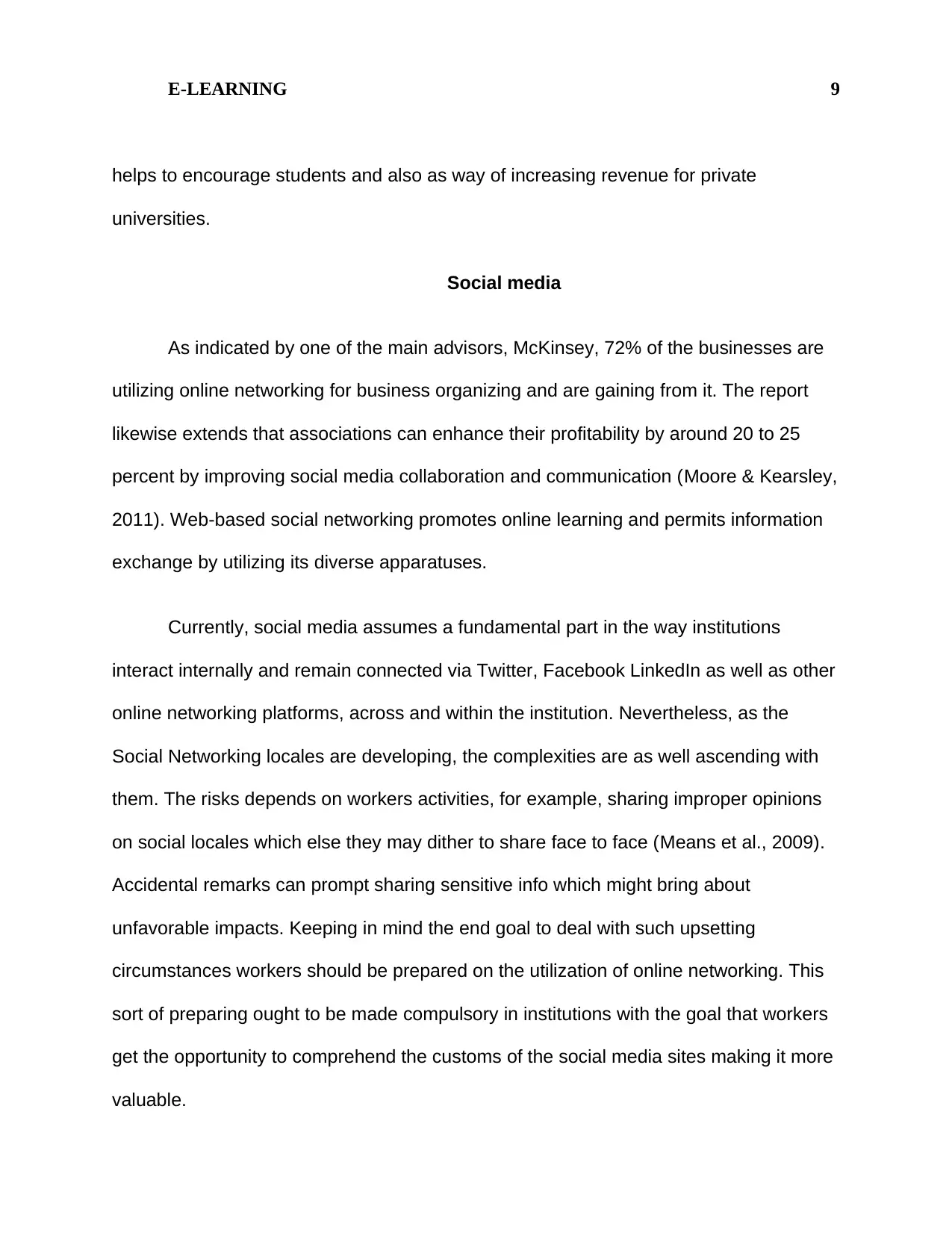
E-LEARNING 9
helps to encourage students and also as way of increasing revenue for private
universities.
Social media
As indicated by one of the main advisors, McKinsey, 72% of the businesses are
utilizing online networking for business organizing and are gaining from it. The report
likewise extends that associations can enhance their profitability by around 20 to 25
percent by improving social media collaboration and communication (Moore & Kearsley,
2011). Web-based social networking promotes online learning and permits information
exchange by utilizing its diverse apparatuses.
Currently, social media assumes a fundamental part in the way institutions
interact internally and remain connected via Twitter, Facebook LinkedIn as well as other
online networking platforms, across and within the institution. Nevertheless, as the
Social Networking locales are developing, the complexities are as well ascending with
them. The risks depends on workers activities, for example, sharing improper opinions
on social locales which else they may dither to share face to face (Means et al., 2009).
Accidental remarks can prompt sharing sensitive info which might bring about
unfavorable impacts. Keeping in mind the end goal to deal with such upsetting
circumstances workers should be prepared on the utilization of online networking. This
sort of preparing ought to be made compulsory in institutions with the goal that workers
get the opportunity to comprehend the customs of the social media sites making it more
valuable.
helps to encourage students and also as way of increasing revenue for private
universities.
Social media
As indicated by one of the main advisors, McKinsey, 72% of the businesses are
utilizing online networking for business organizing and are gaining from it. The report
likewise extends that associations can enhance their profitability by around 20 to 25
percent by improving social media collaboration and communication (Moore & Kearsley,
2011). Web-based social networking promotes online learning and permits information
exchange by utilizing its diverse apparatuses.
Currently, social media assumes a fundamental part in the way institutions
interact internally and remain connected via Twitter, Facebook LinkedIn as well as other
online networking platforms, across and within the institution. Nevertheless, as the
Social Networking locales are developing, the complexities are as well ascending with
them. The risks depends on workers activities, for example, sharing improper opinions
on social locales which else they may dither to share face to face (Means et al., 2009).
Accidental remarks can prompt sharing sensitive info which might bring about
unfavorable impacts. Keeping in mind the end goal to deal with such upsetting
circumstances workers should be prepared on the utilization of online networking. This
sort of preparing ought to be made compulsory in institutions with the goal that workers
get the opportunity to comprehend the customs of the social media sites making it more
valuable.
⊘ This is a preview!⊘
Do you want full access?
Subscribe today to unlock all pages.

Trusted by 1+ million students worldwide

E-LEARNING 10
Benefits
They is a rapid response to various inquiries posted. Distinctive benefactors have
alternate points of view that identify with content which are posted on the social media
platforms. Along these lines, one can find solutions to particular difficulties (Mairal et al.,
2010). Clients create shared understanding as the cooperation amongst associates and
groups increments, in this way learning keeps on developing. Online networking can be
utilized as the supplement for different learning purposes. It might likewise attract
students to a formal guideline
Long range interpersonal communication in a learning organization is tied in with
accomplishing the set targets and enhancing continually. When investigating how Social
Media impacts e-learning. Post sites to teach the group of people on most recent
patterns in e-taking in, its significance and bestowing savvy training. Online classes,
whitepapers on Instructional Design procedures, hypotheses, and exchanges on quick
composing apparatuses assemble e-learning arrangements. This has a far reaching of
information quicker. Move toward becoming individuals from LinkedIn and take an
interest in the industry-particular group and add to different exchanges identified with e-
learning. Utilize YouTube to bestow learning through fewer modules that exhibit the
highlights of the products (Huang, 2002). Offer free courses with the goal that the clients
encounter the product worth and quality.
Benefits
They is a rapid response to various inquiries posted. Distinctive benefactors have
alternate points of view that identify with content which are posted on the social media
platforms. Along these lines, one can find solutions to particular difficulties (Mairal et al.,
2010). Clients create shared understanding as the cooperation amongst associates and
groups increments, in this way learning keeps on developing. Online networking can be
utilized as the supplement for different learning purposes. It might likewise attract
students to a formal guideline
Long range interpersonal communication in a learning organization is tied in with
accomplishing the set targets and enhancing continually. When investigating how Social
Media impacts e-learning. Post sites to teach the group of people on most recent
patterns in e-taking in, its significance and bestowing savvy training. Online classes,
whitepapers on Instructional Design procedures, hypotheses, and exchanges on quick
composing apparatuses assemble e-learning arrangements. This has a far reaching of
information quicker. Move toward becoming individuals from LinkedIn and take an
interest in the industry-particular group and add to different exchanges identified with e-
learning. Utilize YouTube to bestow learning through fewer modules that exhibit the
highlights of the products (Huang, 2002). Offer free courses with the goal that the clients
encounter the product worth and quality.
Paraphrase This Document
Need a fresh take? Get an instant paraphrase of this document with our AI Paraphraser
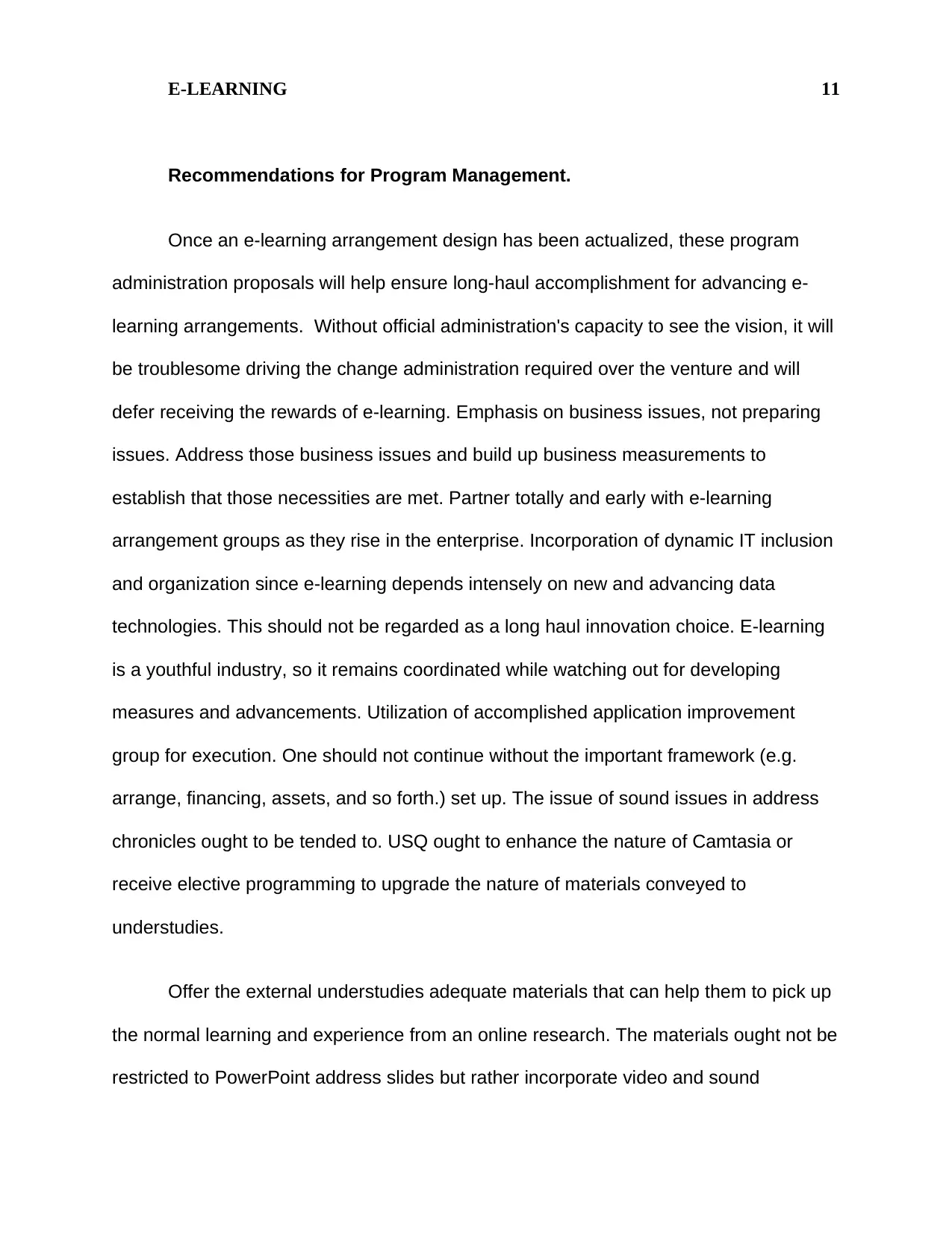
E-LEARNING 11
Recommendations for Program Management.
Once an e-learning arrangement design has been actualized, these program
administration proposals will help ensure long-haul accomplishment for advancing e-
learning arrangements. Without official administration's capacity to see the vision, it will
be troublesome driving the change administration required over the venture and will
defer receiving the rewards of e-learning. Emphasis on business issues, not preparing
issues. Address those business issues and build up business measurements to
establish that those necessities are met. Partner totally and early with e-learning
arrangement groups as they rise in the enterprise. Incorporation of dynamic IT inclusion
and organization since e-learning depends intensely on new and advancing data
technologies. This should not be regarded as a long haul innovation choice. E-learning
is a youthful industry, so it remains coordinated while watching out for developing
measures and advancements. Utilization of accomplished application improvement
group for execution. One should not continue without the important framework (e.g.
arrange, financing, assets, and so forth.) set up. The issue of sound issues in address
chronicles ought to be tended to. USQ ought to enhance the nature of Camtasia or
receive elective programming to upgrade the nature of materials conveyed to
understudies.
Offer the external understudies adequate materials that can help them to pick up
the normal learning and experience from an online research. The materials ought not be
restricted to PowerPoint address slides but rather incorporate video and sound
Recommendations for Program Management.
Once an e-learning arrangement design has been actualized, these program
administration proposals will help ensure long-haul accomplishment for advancing e-
learning arrangements. Without official administration's capacity to see the vision, it will
be troublesome driving the change administration required over the venture and will
defer receiving the rewards of e-learning. Emphasis on business issues, not preparing
issues. Address those business issues and build up business measurements to
establish that those necessities are met. Partner totally and early with e-learning
arrangement groups as they rise in the enterprise. Incorporation of dynamic IT inclusion
and organization since e-learning depends intensely on new and advancing data
technologies. This should not be regarded as a long haul innovation choice. E-learning
is a youthful industry, so it remains coordinated while watching out for developing
measures and advancements. Utilization of accomplished application improvement
group for execution. One should not continue without the important framework (e.g.
arrange, financing, assets, and so forth.) set up. The issue of sound issues in address
chronicles ought to be tended to. USQ ought to enhance the nature of Camtasia or
receive elective programming to upgrade the nature of materials conveyed to
understudies.
Offer the external understudies adequate materials that can help them to pick up
the normal learning and experience from an online research. The materials ought not be
restricted to PowerPoint address slides but rather incorporate video and sound

E-LEARNING 12
recording. The product and e-learning framework instruments ought to be perfect with
prominent stages and working frameworks, for example, the Apple Macintosh working
framework.
References
Allen, I. E., & Seaman, J. (2007). Online nation: Five years of growth in online learning.
Sloan Consortium. PO Box 1238, Newburyport, MA 01950.
Allen, I. E., & Seaman, J. (2010). Learning on Demand: Online Education in the United
States, 2009. Sloan Consortium. PO Box 1238, Newburyport, MA 01950.
Ally, M. (2004). Foundations of educational theory for online learning. Theory and
practice of online learning, 2, 15-44.
Anderson, T. (2004). Towards a theory of online learning. Theory and practice of online
learning, 2, 109-119.
Anderson, T. (Ed.). (2008). The theory and practice of online learning. Athabasca
University Press.
Dabbagh, N., & Bannan-Ritland, B. (2005). Online learning: Concepts, strategies, and
application (pp. 68-107). Upper Saddle River, NJ: Pearson/Merrill/Prentice Hall.
Duchi, J., Hazan, E., & Singer, Y. (2011). Adaptive subgradient methods for online
learning and stochastic optimization. Journal of Machine Learning
Research, 12(Jul), 2121-2159.
Garrison, D. R., & Cleveland-Innes, M. (2005). Facilitating cognitive presence in online
learning: Interaction is not enough. The American journal of distance
education, 19(3), 133-148.
Herrington, J., Oliver, R., & Reeves, T. C. (2003). Patterns of engagement in authentic
online learning environments. Australasian Journal of Educational
Technology, 19(1).
Hoffman, M., Bach, F. R., & Blei, D. M. (2010). Online learning for latent dirichlet
allocation. In advances in neural information processing systems (pp. 856-864).
recording. The product and e-learning framework instruments ought to be perfect with
prominent stages and working frameworks, for example, the Apple Macintosh working
framework.
References
Allen, I. E., & Seaman, J. (2007). Online nation: Five years of growth in online learning.
Sloan Consortium. PO Box 1238, Newburyport, MA 01950.
Allen, I. E., & Seaman, J. (2010). Learning on Demand: Online Education in the United
States, 2009. Sloan Consortium. PO Box 1238, Newburyport, MA 01950.
Ally, M. (2004). Foundations of educational theory for online learning. Theory and
practice of online learning, 2, 15-44.
Anderson, T. (2004). Towards a theory of online learning. Theory and practice of online
learning, 2, 109-119.
Anderson, T. (Ed.). (2008). The theory and practice of online learning. Athabasca
University Press.
Dabbagh, N., & Bannan-Ritland, B. (2005). Online learning: Concepts, strategies, and
application (pp. 68-107). Upper Saddle River, NJ: Pearson/Merrill/Prentice Hall.
Duchi, J., Hazan, E., & Singer, Y. (2011). Adaptive subgradient methods for online
learning and stochastic optimization. Journal of Machine Learning
Research, 12(Jul), 2121-2159.
Garrison, D. R., & Cleveland-Innes, M. (2005). Facilitating cognitive presence in online
learning: Interaction is not enough. The American journal of distance
education, 19(3), 133-148.
Herrington, J., Oliver, R., & Reeves, T. C. (2003). Patterns of engagement in authentic
online learning environments. Australasian Journal of Educational
Technology, 19(1).
Hoffman, M., Bach, F. R., & Blei, D. M. (2010). Online learning for latent dirichlet
allocation. In advances in neural information processing systems (pp. 856-864).
⊘ This is a preview!⊘
Do you want full access?
Subscribe today to unlock all pages.

Trusted by 1+ million students worldwide
1 out of 13
Related Documents
Your All-in-One AI-Powered Toolkit for Academic Success.
+13062052269
info@desklib.com
Available 24*7 on WhatsApp / Email
![[object Object]](/_next/static/media/star-bottom.7253800d.svg)
Unlock your academic potential
Copyright © 2020–2026 A2Z Services. All Rights Reserved. Developed and managed by ZUCOL.





